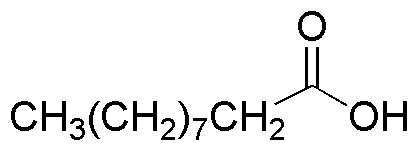Decanoic acid is widely utilized in research focused on:
- Food Industry: Used as a flavoring agent and preservative in various food products, enhancing taste while providing antimicrobial properties.
- Cosmetics and Personal Care: Incorporated in formulations for creams and lotions due to its emollient properties, helping to moisturize and soften the skin.
- Pharmaceuticals: Serves as a medium-chain fatty acid in drug formulations, improving solubility and bioavailability of certain medications.
- Biofuels: Acts as a potential feedstock for biodiesel production, contributing to renewable energy solutions and reducing reliance on fossil fuels.
- Industrial Applications: Used in the production of surfactants and detergents, providing effective cleaning properties while being biodegradable.
Información general
Propiedades
Seguridad y normativas
Aplicaciones
Decanoic acid is widely utilized in research focused on:
- Food Industry: Used as a flavoring agent and preservative in various food products, enhancing taste while providing antimicrobial properties.
- Cosmetics and Personal Care: Incorporated in formulations for creams and lotions due to its emollient properties, helping to moisturize and soften the skin.
- Pharmaceuticals: Serves as a medium-chain fatty acid in drug formulations, improving solubility and bioavailability of certain medications.
- Biofuels: Acts as a potential feedstock for biodiesel production, contributing to renewable energy solutions and reducing reliance on fossil fuels.
- Industrial Applications: Used in the production of surfactants and detergents, providing effective cleaning properties while being biodegradable.
Documentos
Hojas de datos de seguridad (HDS)
La SDS proporciona información de seguridad completa sobre la manipulación, el almacenamiento y la eliminación del producto.
Especificación del producto (PS)
La PS proporciona un desglose completo de las propiedades del producto, incluida la composición química, el estado físico, la pureza y los requisitos de almacenamiento. También detalla los rangos de calidad aceptables y las aplicaciones previstas del producto.
Certificados de análisis (COA)
Busque certificados de análisis (COA) ingresando el número de lote del producto. Los números de lote y de partida se pueden encontrar en la etiqueta de un producto después de las palabras "Lote" o "Lote".
Número de catálogo
Número de lote/lote
Certificados de origen (COO)
Este certificado de origen confirma el país en el que se fabricó el producto y también detalla los materiales y componentes utilizados en él y si se deriva de fuentes naturales, sintéticas u otras fuentes específicas. Este certificado puede ser necesario para cumplir con las normativas aduaneras, comerciales y regulatorias.
Número de catálogo
Número de lote/lote
Hojas de datos de seguridad (HDS)
La SDS proporciona información de seguridad completa sobre la manipulación, el almacenamiento y la eliminación del producto.
DownloadEspecificación del producto (PS)
La PS proporciona un desglose completo de las propiedades del producto, incluida la composición química, el estado físico, la pureza y los requisitos de almacenamiento. También detalla los rangos de calidad aceptables y las aplicaciones previstas del producto.
DownloadCertificados de análisis (COA)
Busque certificados de análisis (COA) ingresando el número de lote del producto. Los números de lote y de partida se pueden encontrar en la etiqueta de un producto después de las palabras "Lote" o "Lote".
Número de catálogo
Número de lote/lote
Certificados de origen (COO)
Este certificado de origen confirma el país en el que se fabricó el producto y también detalla los materiales y componentes utilizados en él y si se deriva de fuentes naturales, sintéticas u otras fuentes específicas. Este certificado puede ser necesario para cumplir con las normativas aduaneras, comerciales y regulatorias.

